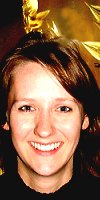|
As competition manager of the
BG Wildlife Photographer of the Year Competition, Louise Grove-White
is in charge of the largest and most respected wildlife photography
competition in the world organised by The Natural History Museum
and BBC Wildlife Magazine. Based at the Museum, she is also in charge
of the resulting exhibition which runs there from October to Easter
each year, and for the tour of the exhibition which travels to venues
all over the world.
"My job is exciting because
it's a multi-discipline role. Yesterday I was at the printers for
most of the day watching the entry form for the 2001 competition
come off the presses & today I'm doing press interviews & tomorrow
I'm talking to an American photographer about his latest project
photographing wolves in Spain. Every day is different, so there's
never any time to sit back and think 'oh no, work again'.
"Since it started in the 1960's
the competition has grown massively. In the early days they only
had a couple of hundred entries, with the competition judging taking
place in Eric Hosking's front room. Last year we received over 19,000
entries and the judging process went on non-stop for eight weeks,
with thirteen judges in all taking part.
"The whole ethos of the competition
is that each image should be judged on its own merits. We never
ask photographers whether they are amateur or professional for this
reason. The actual judging of the images is done 'blind', that is
with the images projected so they are unaware of who has taken which
photograph. At the end of the judging period the panel will have
chosen about 120 images for the exhibition. Luckily, I don't have
to make any of the decisions because I think it would drive me mad
seeing so many pictures.
"It's fascinating to look back
a few years to see how much photography has changed. In the early
years of the competition there was an emphasis on documenting behaviour,
with less emphasis on what the photograph looked like. Nowadays
the public are all much more sophisticated in our knowledge of animal
behaviour because of the exposure wildlife gets on television, so
the judges are just as interested in the aesthetic of the photograph.
"Of course there are always
notable exceptions to this. Two years ago for instance, we received
an image of a pod of sperm whales swimming very tightly together.
In the middle of the pod there was one female who had flipped over
and was swimming on her back, and in her mouth was her stillborn
calf. It turned out that this was the first time this behaviour
had ever been documented, and because of this the judges felt the
photograph should be recognised in some way. So even though it may
not have been one of the most beautiful images it's interest value
warranted a Highly Commended award.
"Every October all the winners
are invited to an awards ceremony and dinner at The Natural History
Museum which takes place around the dinosaur in the main hall. We
fly the entrants in from all round the world and entertain them
for a few days in London. This is always really interesting for
us, because up to this point we are have only been dealing with
names and voices on the phone. When they come over they are sometimes
not how you would imagine them to be at all.
"We also invite celebrities
associated with wildlife along to the ceremony. Last year we had
Andrew Sachs the actor, Charlotte Uhlenbroek who presented the wonderful
'Cousins' primate series, and Michaela Strachan from BBC's Really
Wild Show. We even had Pat from East Enders last year, because she
does a lot of fundraising work for one of the tiger foundations.
So its really nice meeting these personalities who have another
string to their bow.
"Sometimes the competition
can really change the life of an entrant. We have a junior competition
running alongside the adult competition, and one of the winners
in 1999 was a 12 year-old girl called Becky Chadd from Guildford.
She won her category with a wonderful picture of a swan. It turned
out that her dad had just taken up photography and she used to go
out with him and use his camera sometimes. She brought her father
along to the presentation and he was totally overwhelmed and so
proud of his daughter.
"The press interest in her
picture was phenomenal. The Daily Mail took her to do a shoot at
London Zoo and featured her photographs in the paper, along with
an article about her. London Zoo gave her a free pass for whenever
she wanted to visit & an American Ballet company who were doing
a production of Swan Lake used her photograph to advertise their
ballet. All this happening to this little girl, it was fantastic.
"With the prize money she bought
herself a camera, and then came back in 2000 and won her category
again. Hopefully we have really stimulated an interest in wildlife
photography for her in the future.
"Although we do always have
many female winners of the competition, wildlife photography is
still very male dominated, so success stories like Becky's are really
inspiring."
The 2000 exhibition is now on
at The Natural History Museum until 22 April and if you want to
enter the 2001 competition you have until 5 April to send your entries
in.
Entry forms are available from
the competition office 020 7942 5015 or through the website www.nhm.ac.uk/wildphoto
|

